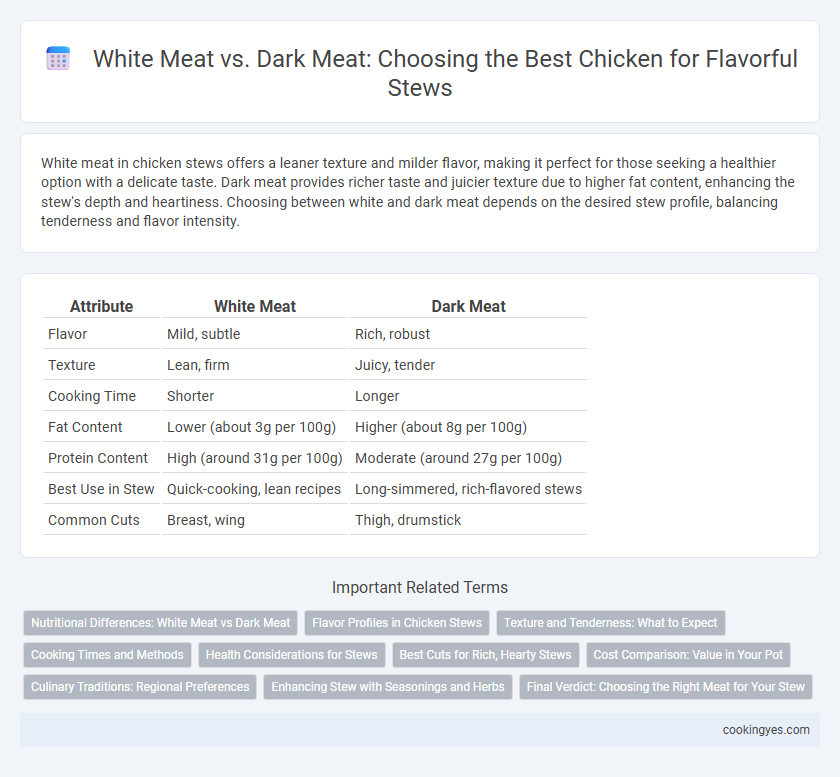White meat in chicken stews offers a leaner texture and milder flavor, making it perfect for those seeking a healthier option with a delicate taste. Dark meat provides richer taste and juicier texture due to higher fat content, enhancing the stew's depth and heartiness. Choosing between white and dark meat depends on the desired stew profile, balancing tenderness and flavor intensity.
Table of Comparison
| Attribute | White Meat | Dark Meat |
|---|---|---|
| Flavor | Mild, subtle | Rich, robust |
| Texture | Lean, firm | Juicy, tender |
| Cooking Time | Shorter | Longer |
| Fat Content | Lower (about 3g per 100g) | Higher (about 8g per 100g) |
| Protein Content | High (around 31g per 100g) | Moderate (around 27g per 100g) |
| Best Use in Stew | Quick-cooking, lean recipes | Long-simmered, rich-flavored stews |
| Common Cuts | Breast, wing | Thigh, drumstick |
Nutritional Differences: White Meat vs Dark Meat
White meat from chicken, primarily breast meat, is lower in fat and calories while providing a higher protein content, making it ideal for leaner chicken stews focused on muscle maintenance and weight management. Dark meat, found in thighs and drumsticks, contains more iron, zinc, and B vitamins, along with a richer fat content that enhances flavor and provides additional energy. Nutritionally, white meat supports low-fat diets, whereas dark meat offers greater nutrient density and sustained energy release, important factors when choosing ingredients for chicken stews.
Flavor Profiles in Chicken Stews
White meat in chicken stews offers a mild, tender flavor that absorbs herbs and spices quickly, creating a subtle and clean taste. Dark meat provides a richer, more robust flavor with higher fat content, adding depth and a slightly gamey, juicy texture to the stew. Choosing dark meat enhances the overall savory complexity, making it ideal for hearty, slow-cooked chicken stews.
Texture and Tenderness: What to Expect
White meat in chicken stews offers a firmer texture and tends to be leaner, which can result in a slightly drier outcome if overcooked. Dark meat contains more fat and collagen, contributing to a richer flavor profile and a tender, juicier consistency after slow cooking. Expect white meat to retain a mild texture, while dark meat breaks down more easily, enhancing the stew's overall succulence and mouthfeel.
Cooking Times and Methods
White meat in chicken stews, consisting mainly of breast meat, cooks faster due to its lower fat content and lean texture, typically requiring simmering for 20-30 minutes to avoid drying out. Dark meat, such as thighs and drumsticks, contains higher fat and connective tissue, benefiting from longer cooking times of 40-60 minutes to become tender and flavorful. Slow simmering or braising methods help break down collagen in dark meat, enhancing juiciness and rich taste, while white meat requires careful temperature control to maintain moisture.
Health Considerations for Stews
White meat in chicken stews offers lower fat content and fewer calories, making it a healthier option for those monitoring cholesterol and weight. Dark meat contains higher levels of iron, zinc, and certain B vitamins, which support immune function and energy metabolism. Choosing the meat type for stews depends on balancing calorie intake with nutritional benefits relevant to individual health goals.
Best Cuts for Rich, Hearty Stews
White meat, primarily from chicken breasts, offers a lean texture that absorbs flavors well but can become dry in long-cooked stews. Dark meat, including thighs and drumsticks, contains more fat and connective tissue, which breaks down during slow cooking, enriching stews with a deep, juicy flavor and tender texture. For rich, hearty chicken stews, choosing dark meat cuts like thighs or legs is optimal to achieve a robust taste and satisfying mouthfeel.
Cost Comparison: Value in Your Pot
White meat chicken, typically from the breast, is often more expensive per pound than dark meat, such as thighs or drumsticks, making dark meat a budget-friendly choice for chicken stews. Dark meat offers richer flavor and increased moisture, enhancing the stew's taste and texture while providing better value for cost-conscious cooks. Opting for dark meat can stretch your grocery budget further without sacrificing the savory depth needed in hearty chicken stews.
Culinary Traditions: Regional Preferences
White meat, favored in many Western culinary traditions for chicken stews, offers a leaner texture and milder flavor, particularly popular in American and European recipes. Dark meat, rich in fat and collagen, is preferred in Southern and Asian cuisines, providing a juicier, more flavorful base essential for slow-cooked stews. Regional preferences strongly influence the choice between white and dark meat, shaping the stew's taste profile and nutritional content.
Enhancing Stew with Seasonings and Herbs
White meat in chicken stews offers a mild flavor and tender texture that absorbs seasonings and herbs like thyme, rosemary, and garlic effectively, enhancing the overall taste profile. Dark meat contains more fat and connective tissue, providing richer flavor and juiciness, which intensifies the stew's depth when combined with bold spices such as smoked paprika, cumin, and bay leaves. Balancing white and dark meat with complementary herbs and seasonings creates a harmonious blend of flavors and textures, elevating the complexity of chicken stews.
Final Verdict: Choosing the Right Meat for Your Stew
White meat in chicken stews offers a mild flavor and lean texture, ideal for lighter broths and quicker cooking times. Dark meat provides richer taste and higher fat content, enhancing depth and tenderness, especially in slow-cooked stews. Selecting white meat suits health-conscious dishes with subtle flavors, while dark meat delivers robust, hearty stew experiences.
White Meat vs Dark Meat for Chicken Stews Infographic

 cookingyes.com
cookingyes.com